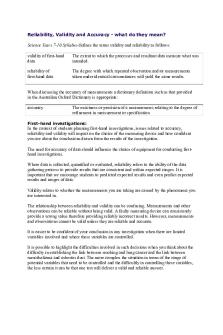Reliability - Professor: Eyran Gisches PDF

| Title | Reliability - Professor: Eyran Gisches |
|---|---|
| Course | Basic Operations Management |
| Institution | University of Arizona |
| Pages | 4 |
| File Size | 301.7 KB |
| File Type | |
| Total Downloads | 44 |
| Total Views | 134 |
Summary
Professor: Eyran Gisches...
Description
Chapter 4s
MIS 373
Lecture Notes
Reliability o Reliability The ability of a product, part, or system to perform its intended function under a prescribed set of conditions Reliability is expressed as a probability *The probability that the product or system will function when activated The probability that the product or system will function for a given length of time o Reliability – When Activated Finding the probability under the assumption that the system consists of a number of independent components Requires the use of probabilities for independent events Independent Event: Events whose occurrence or non-occurrence do not influence one another Rule 1 If two or more events are independent and success if defined as the probability that ALL of the events occur, then the probability of success is equal to the product of the probabilities of the events P = P1 * P2 Though individual system components may have high reliabilities, the system’s reliability may be considerably lower because all components that are in series must function One way to enhance reliability is to utilize redundancy Redundancy: The use of backup components to increase reliability Rule 2 If two events are independent and success is defined as the probability that AT LEAST one of the events will occur, the probability of success is equal to the probability that (either) one occurs plus 1.00 minus that probability multiplied by the probability the other occurs P = P1 + (1 – P1)(P2) Rule 3 If two or more events are involved and success is defined as the probability that AT LEAST ONE of them occurs, the probability of success is 1 – P(all fail) 1 – (#1 fails AND #2 fails AND #3 fails and so on…) 1 – [(1 – P1)*(1 – P2)*(1-P3)…] Can also be calculated by using Rule 2 multiple times
Chapter 4s
MIS 373
Lecture Notes
Rule 2 & Rule 3 are interchangeable o Example: System Reliability
o Reliability Over Time Reliabilities are determined relative to a specified length of time Commonly used when establishing warranty periods o Improving Reliability Redundancy/backups Component Design System Design Production/assembly techniques Testing
Chapter 4s
MIS 373
Lecture Notes
Preventive maintenance procedures User education
WILL NOT BE ON EXAM: o Maintenance All activities that maintain facilities and equipment in good working order so that a system can perform as intended Goal: keep the production system in good working order at minimal cost Reactive/Breakdown maintenance Dealing with breakdowns or problems when they occur Proactive/Preventive maintenance Reducing likelihood of breakdowns o Total Maintenance Cost Goal: strike a balance between cost of preventive maintenance and cost of breakdown The amount of preventive maintenance is a function of the expected frequency of breakdown, the cost of breakdown, and the cost of preventive maintenance
o Preventative vs. Breakdown Maintenance Looking at historical data, monthly breakdown frequency is:
Repair cost is $1,000 Cost of preventive maintenance is $1,250 If preventive maintenance is performed, the probability of a machine breakdown is negligible Should preventive maintenance be done, or would it be cheaper to repair the machine when it breaks down? o Preventative vs. Breakdown Maintenance Expected number of breakdowns per month:
Chapter 4s
MIS 373
Lecture Notes
0.2*0+0.3*1+0.4*2+0.1*3 = 1.4 breakdowns/month Expected repair cost per month: 1.4*1,000 = $1,400/month Cost of preventive maintenance is $1,250 per month Since $1,250 < $1,400, preventive maintenance is cheaper than breakdown maintenance o Total Maintenance Cost Including Downtime
CLICKER
QUESTIONS
1. The reliability of a Rube Goldberg machine can be calculated using: a. Rule 1 2. Adding a component to a system will affect reliability in this way: a. All are possible (increase, decrease, not change) i. Increase by a backup ii. Decrease by adding more features that must function iii. Not change by adding a component with 100% reliability or by adding a backup with 0% reliability...
Similar Free PDFs

Reliability - notes
- 9 Pages

Reliability analysis in Excel
- 7 Pages

Types of Reliability
- 10 Pages

Calculation OF Reliability Index
- 1 Pages

Reliability-Outline:Study Guide
- 12 Pages

Reliability and Validity Notes
- 4 Pages

Reliability, validity and bias
- 1 Pages

Accuracy Reliability Validity
- 14 Pages

11. Correlation and Reliability
- 4 Pages
Popular Institutions
- Tinajero National High School - Annex
- Politeknik Caltex Riau
- Yokohama City University
- SGT University
- University of Al-Qadisiyah
- Divine Word College of Vigan
- Techniek College Rotterdam
- Universidade de Santiago
- Universiti Teknologi MARA Cawangan Johor Kampus Pasir Gudang
- Poltekkes Kemenkes Yogyakarta
- Baguio City National High School
- Colegio san marcos
- preparatoria uno
- Centro de Bachillerato Tecnológico Industrial y de Servicios No. 107
- Dalian Maritime University
- Quang Trung Secondary School
- Colegio Tecnológico en Informática
- Corporación Regional de Educación Superior
- Grupo CEDVA
- Dar Al Uloom University
- Centro de Estudios Preuniversitarios de la Universidad Nacional de Ingeniería
- 上智大学
- Aakash International School, Nuna Majara
- San Felipe Neri Catholic School
- Kang Chiao International School - New Taipei City
- Misamis Occidental National High School
- Institución Educativa Escuela Normal Juan Ladrilleros
- Kolehiyo ng Pantukan
- Batanes State College
- Instituto Continental
- Sekolah Menengah Kejuruan Kesehatan Kaltara (Tarakan)
- Colegio de La Inmaculada Concepcion - Cebu






